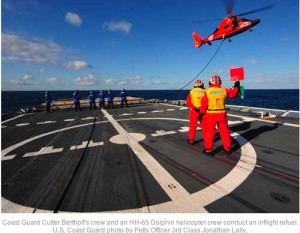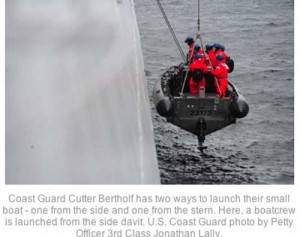07/05/2011
MONDAY, MAY 9, 2011
As one of the Coast Guard’s newest assets, the national security cutters bring operational capabilities the fleet needs for mission success. Compass has asked the wardroom of Coast Guard Cutter Bertholf, the service’s first NSC, to share their unique perspective on how the fleet’s newest class of cutters will perform in the world’s most challenging operating environments, and this week’s update comes from the ship’s commanding officer, Capt. John Prince. You can also also stop by Coast Guard Alaska for the view from the deck plate, focusing on Bertholf’s day to day operations that make their missions a success.
Written by Capt. John Prince, commanding officer, Coast Guard Cutter Bertholf.
Greetings from the Bering Sea. We’ve been underway for more than a month on the first Alaska patrol for a national security cutter, and I can say it has been a truly impressive performance by the ship and our crew.
We’ve experienced 20-foot seas and winds in excess of 60 knots with temperatures below freezing, and despite these sea conditions the ship has remained within pitch and roll limits to launch our helicopter. We have been able to make a comfortable 12 to 15 knots through the water in seas up to 14 feet, validating the sea keeping and stability of the NSC and our ability to respond quickly to any emergency.

Our 12,000 nautical mile range at economical speed, and 8,000 nautical mile range at a speed of 14 knots has allowed us to remain at sea for more than 24 days at a time and cover large swaths of the ocean with our sensors and helicopter, while still maintaining a fuel reserve in the event of emergency.
Keeping our stability well within safe limits without concern over low fuel levels, our installed ballast tanks help us to better preserve and protect the marine environment as we are not ballasting tanks that previously held fuel like on the 378-foot high endurance cutter.
Our boarding teams have conducted close to 20 safe and effective fisheries law enforcement boardings in seas up to eight feet, on vessels ranging from 58 feet to more than 200 feet, ensuring the fishing fleet is safe and earning their living in accordance with U.S. rules and regulations. Our helicopter has conducted more than a dozen flights observing the fishing fleet and remains at the ready for medevac and provisioning.
When most folks think of ALPAT they immediately have visions of rough weather, bitter cold and dramatic rescues as captured on the “Deadliest Catch.” That certainly is a part of this mission, but by no means captures its depth and scope.
ALPAT is a 365 days a year national sovereignty, economic security, living marine resource protection and search and rescue mission that encompasses hundreds of thousands of square miles of the North Pacific and Arctic Ocean, thousands of miles of coastline and hundreds of marine sanctuaries and other protected areas.
As the long maritime arm of the Department of Homeland Security, we guard our international maritime boundaries and exclusive economic zones responding to incursions by foreign fishing vessels and others who should not be in our waters to ensure the security of our homeland and protection of our natural resources.
In partnership with other federal, state tribal and local agencies, we ensure that fishing activities are conducted in accordance with the rules and regulations that not only govern how fishing is conducted, but also where, when and how much fish can be harvested to ensure a sustainable fish population that is vital to our national and economic security.
More than 60 percent of the United States’ commercial seafood harvests come from Alaska, with more than five billion pounds of fish and shellfish harvested annually. The resources we are protecting are extremely valuable and as we have seen in other countries, once the stocks are depleted the fish don’t return. We patrol and observe Stellar sea lion rookeries and other critical marine habitats and preservation areas to protect and preserve endangered species and the natural beauty of Alaska. And, as seen on TV, we battle oftentimes harsh sea conditions to safeguard our fellow citizens from the perils of the sea and one of the most dangerous U.S. professions – commercial fishing.
This is no easy task, and it takes a highly capable ship and crew, equipped with the right tools, command and control systems, onboard sensors, information exchange and weapons systems. The ship must be able to get on scene quickly, maintain continuous presence for extended periods, monitor the areas with sensors and carry out the mission using a variety of tools such as small boats and helicopters. And it must be able to do all these things in both fair and foul weather.

From what I have observed on this patrol, and during previous patrols on Bertholf as far south as South America, the national security cutter is that ship and more. And as our fleet of high endurance cutters that diligently conducted this mission for the past four decades are retired, the national security cutter will be the right ship in the Coast Guard fleet to safely and effectively carry out these missions.
It is truly exhilarating as a sailor and cutterman to see what this optimally crewed ship is capable of – fast, quiet, a good ride, environmentally friendly, top notch sensors, weapons systems and communications suite, a huge and stable flight deck, interoperable with Department of Defense and other partners.
Just recently, we demonstrated U.S. capabilities and commitment to preserving the balance in the Arctic region when we worked with our Russian partners. They were impressed with the high morale and quality of life enjoyed by our crew from berthing areas to the exercise facility to our galley – which was recently selected as the dining facility of the year in the large afloat category for its quality and efficiency. Other than good weather and calm seas, there is not much more I could ask for.
We are learning new and more efficient ways to do things each and every day, and the contributions the national security cutter is making to the Coast Guard, the Department of Homeland Security and our nation will only grow as the days go by. We look forward to continued adventures and success standing a taut watch on the Northern Front, and will share those stories with you as they unfold.
Capt. John Prince is commanding officer of Coast Guard Cutter Bertholf. This is his eighth afloat tour and sixth afloat command. Prior to Bertholf, Prince commanded Coast Guard Cutter Jarvis, a 378-foot high endurance cutter, and completed three Alaska patrols with that ship and crew. He has 26 years of service and more than 16 years afloat on seven different classes of Coast Guard cutters.
Source:

